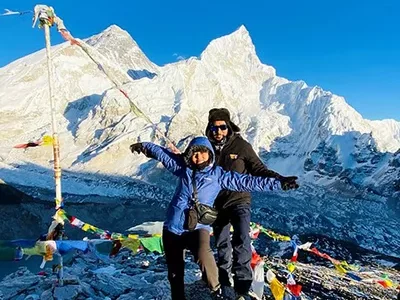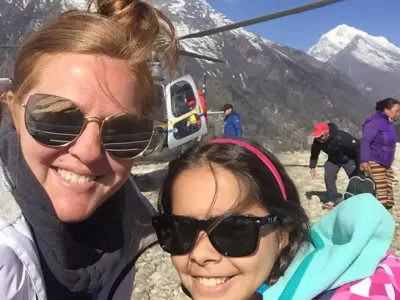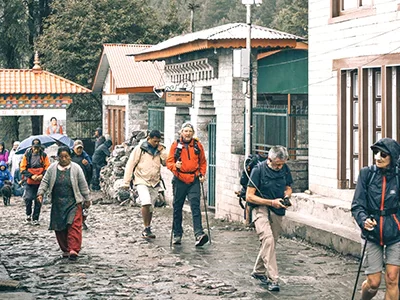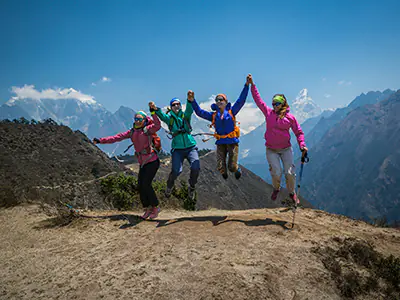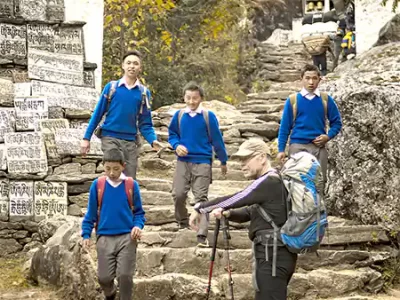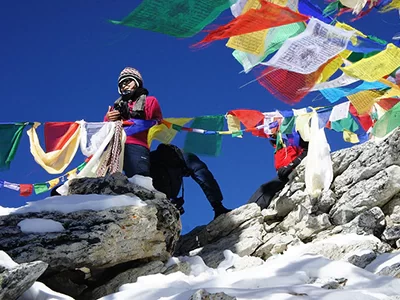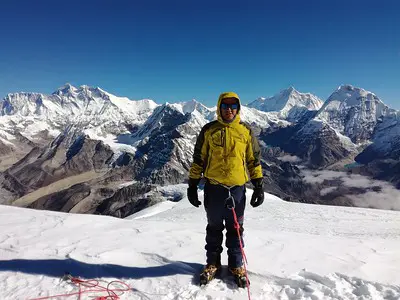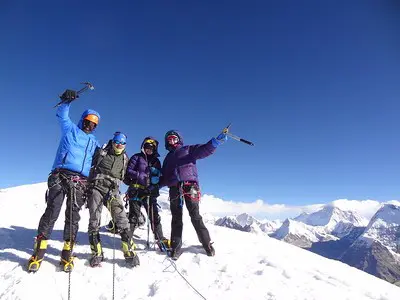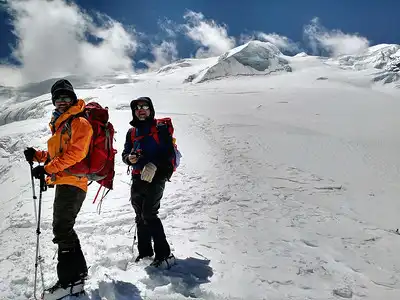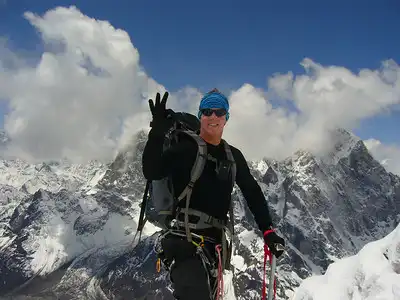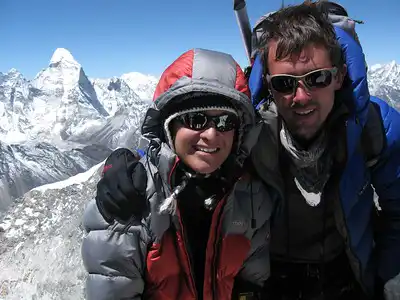Kongma La Pass is one of Nepal’s Everest region’s most exhilarating and demanding high-altitude crossings. Situated at an impressive 5,535 meters (18,159 feet), It connects the stunning Khumbu Valley with the remote Imja Valley. Those who summit this pass are treated to awe-inspiring vistas of the world’s highest peaks, creating an unforgettable memory.
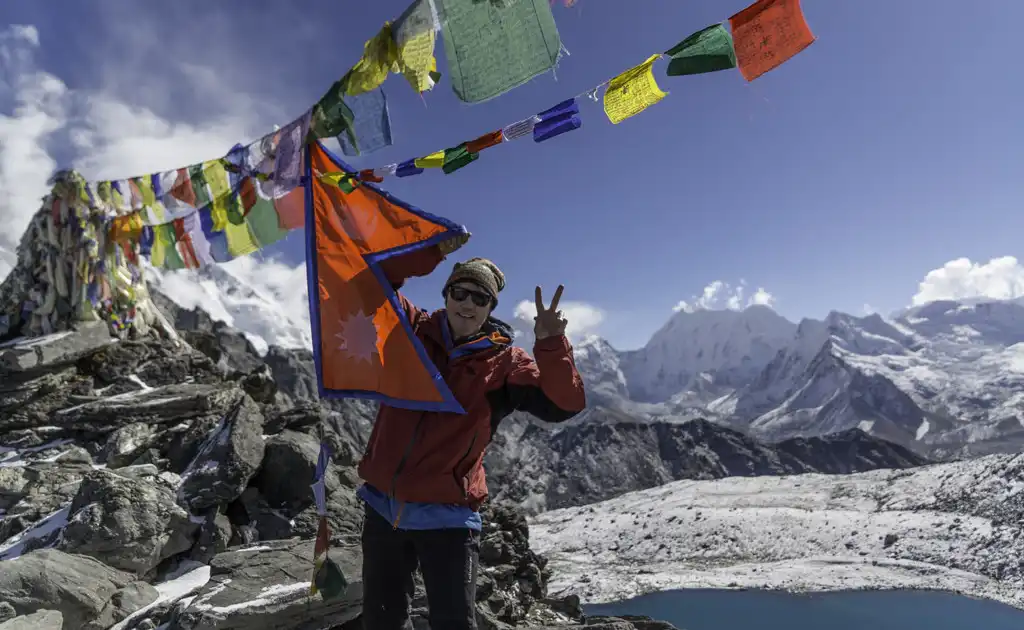
Located in the Sagarmatha National Park, Kongma La Pass is part of the famed Everest Three Passes Trek. It is considered one of the more challenging passes due to its steep climbs, unpredictable weather, and rocky terrain. However, for those well-prepared, the pass offers a rewarding experience, combining adventure with the awe-inspiring beauty of the Himalayas.
The route to Kongma La Pass is often traveled by trekkers looking to add more adventure to their Everest Base Camp trek or those attempting the entire Three Passes route. No matter which direction you approach it from, the pass provides a unique perspective of the Himalayan landscape, with views stretching across some of the region’s most iconic peaks, including Lhotse, Nuptse, Makalu, and Ama Dablam.
Everest Base Camp Trek
Everest Base Camp Trek with Helicopter Return
Luxury Everest Base Camp Trek
Kongma La Pass Altitude: Scaling the Heights in the Himalayas
Kongma La Pass, an iconic landmark in Nepal’s Everest region, stands tall at an impressive altitude of 5,535 meters (18,159 feet). The high elevation makes it a proper high-altitude trek, where thin air and amplified challenges test trekkers’ endurance.
Reaching Kongma La Pass signifies an extraordinary accomplishment, yet comprehending the physiological challenges posed by such high altitudes remains paramount. The diminished oxygen levels at these elevations can trigger altitude sickness, a potentially severe condition manifesting symptoms that include headaches, nausea, breathing difficulties, and even confusion.
Acclimatization: Your Key to Success
The human body is remarkably adaptable but requires time to adjust to high altitudes. Gradual acclimatization is crucial for anyone attempting to cross this place. Here are some key acclimatization strategies:
- Ascend Slowly: Take your time. Incorporate rest days into your travel plan to allow for proper acclimatization.
- Climb High, Sleep Low: During your trek, consider hiking to a higher altitude during the day and then descending to a lower altitude for sleep. This approach helps your body acclimate more effectively.
- Stay Hydrated: Adequate hydration is crucial for countering the dehydrating conditions at high altitudes.
- Listen to Your Body: Your health is paramount. If you experience altitude sickness, do not ignore the warning signs. If necessary, descend to a lower altitude.
- Consider Medication: Consult your doctor about preventive medications for altitude sickness.
Preparing for the Kongma La Pass Altitude
- Physical Fitness: Engage in regular cardiovascular exercise and strength training in the months leading up to your trek.
- Experience: Ideally, prior high-altitude trekking experience before attempting Kongma La Pass.
- Mental Preparation: Be prepared for the physical and mental challenges of high-altitude trekking.
Kongma La Pass Weather: Prepare for the Unpredictable
High in the Himalayas, Kongma La Pass delivers weather as dramatic and unpredictable as its stunning vistas. Hikers must be ready for sudden temperature swings, the possibility of snow, and fierce winds that can sweep across the pass without warning. A successful and safe trek across Kongma La Pass depends on understanding the typical weather patterns for each season.
Prime Trekking Seasons
- Spring (March-May): Spring generally ushers in favorable conditions with milder temperatures and clear skies. Even so, hikers should anticipate occasional snow, particularly at higher elevations.
- Autumn (September – November): Autumn is also a popular time for trekking. It offers stable weather and exceptional visibility. Expect warm days and cold nights.
Weather’s Mood Swings
- Temperature: Kongma La Pass weather is notorious for its extreme temperature fluctuations. While daytime temperatures might feel relatively comfortable, nights can plunge below freezing, even in peak seasons.
- Snow: Snowfall is possible year-round, although it’s more common in winter and early spring. Pack the appropriate gear and stay vigilant about avalanche risks.
- Wind: Strong winds frequently buffet Kongma La Pass, predominantly afternoons and evenings. Wind chill can dramatically decrease the perceived temperature, so layering clothing and protecting yourself from the elements is essential.
Extra Tips for Tackling Kongma La Pass Weather
- Consult forecasts: Before heading out, review the most recent weather forecast for the area and be willing to change your plans if needed.
- Layer up: Dress in layers to quickly adjust to fluctuating temperatures throughout the day.
- Waterproof everything: Rain or snow can appear unexpectedly, so pack waterproof jackets, pants, and gaiters.
- Shield from the sun: Even when cloudy, the high-altitude sun can be powerful. Remember to wear sunscreen, sunglasses, and a hat for sun protection.
Everest Base Camp Trek for Beginners
Everest Panorama Trek
Everest High Pass Trek
Trekking to Kongma La Pass: A Path Less Traveled
Kongma La Pass, often incorporated into the Everest Three Passes Trek, offers a challenging yet rewarding route for experienced trekkers. This high-altitude pass, situated at a formidable 5,535 meters (18,159 feet), demands respect and careful preparation.
Typical Trekking Route
The most common approach to Kongma La Pass is as part of the Everest Three Passes Trek, a multi-week trek that circumnavigates the Everest massif. Here’s a brief overview of the route:
- Namche Bazaar to Dingboche: The trek typically begins in Namche Bazaar, a bustling Sherpa village and gateway to the Khumbu region.

You’ll ascend gradually through lush forests and picturesque villages from there, acclimatizing. Dingboche, a high-altitude settlement with stunning views of Ama Dablam, is a crucial acclimatization stop.
- Dingboche to Lobuche: The trail continues through the Imja Valley, passing by the turquoise waters of Imja Tsho (lake) and offering glimpses of the imposing Lhotse and Nuptse peaks.
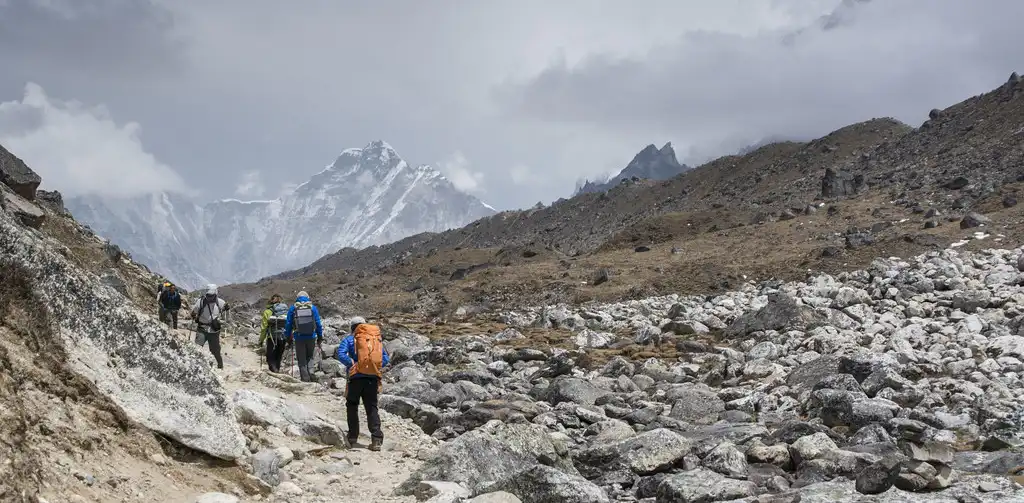
Lobuche, a small village beneath the Khumbu Glacier, is the final stop before tackling Kongma La Pass.
- Lobuche to Kongma La Pass: The ascent to Kongma La Pass is steep and challenging, often requiring crampons and ice axes depending on snow conditions. Trekkers reach the summit and enjoy panoramic views of Everest, Lhotse, Makalu, and other Himalayan giants.
- Kongma La Pass to Chhukung: The descent from the pass is equally demanding. It leads to the village of Chhukung. You can continue on the Everest Three Passes Trek or retrace your steps to Namche Bazaar.
Key Stops
- Dingboche: An essential acclimatization stop with plenty of lodging and dining options.
- Lobuche: The last village before the pass, offering basic accommodation and stunning mountain vistas.
Kongma La Pass: Where the Himalayas Unfold
Rising majestically to 5,535 meters (18,159 feet), Kongma La Pass promises trekkers an unforgettable adventure in the heart of the world’s highest mountains. However, this awe-inspiring pass also presents challenges that demand respect and thorough preparation.
Scenic Wonders: A Visual Symphony
The panoramic vistas from this place will leave you breathless. As you make your way up, the surrounding peaks gradually unveil their grandeur:
- Makalu: The fifth-highest mountain on Earth, Makalu commands the eastern skyline with its distinctive pyramid shape.
- Lhotse: A close companion to Everest, Lhotse’s imposing south face is a sight to remember.
- Nuptse: This sharp, dramatic peak juts out prominently to the west, creating a stark contrast against the surrounding glaciers.
- Ama Dablam: Ama Dablam, often earning the nickname “Matterhorn of the Himalayas,” captivates all who witness its graceful silhouette against the sky.
Challenges and Preparation: Rise to the Occasion
Crossing Kongma La Pass is a challenging feat. The trek involves steep climbs and descents, navigating rocky paths, and traversing snowfields and glaciers. The high altitude adds another layer of difficulty, with the risk of altitude sickness always present. Success on Kongma La Pass requires careful preparation:
- Physical Fitness: Regular cardio workouts and hikes build your stamina and strength.
- Gear Up: Invest in high-quality trekking boots, warm layers, waterproof clothing, and a cozy sleeping bag for cold temperatures. Depending on snow conditions, crampons and an ice axe might be necessary.
- Acclimatize Wisely: Incorporate rest days and gentle ascents into your itinerary to help your body adjust to the altitude.
- Mental Fortitude: Be ready for long days, challenging terrain, and unpredictable weather. A positive mindset and firm determination will carry you far.
- Expert Guidance: Hire a knowledgeable local guide who is familiar with the route and current weather conditions. A porter can lighten your load, allowing you to focus on the trek and acclimatization.
Trekking Safely at High Altitude
Trekking to Kongma La Pass is a thrilling adventure, but the high altitude presents unique challenges that demand careful attention to safety. With its elevation reaching a staggering 5,535 meters (18,159 feet), Kongma La Pass sits in a zone where altitude sickness is a genuine concern. However, with suitable precautions, you can mitigate risks and enjoy a safe and memorable experience.
Prioritize Acclimatization
Acclimatization is your body’s way of adapting to the decreased oxygen levels at high altitudes. Rushing your ascent can lead to altitude sickness, which can have symptoms ranging from headaches and nausea to life-threatening conditions.
- Ascend Gradually: Plan your itinerary with rest days to allow your body to adjust. Avoid gaining more than 300-500 meters (984-1640 feet) in altitude daily.
- Climb High, Sleep Low: Consider hiking to a higher elevation during the day and returning to a lower altitude for sleep.
- Listen to Your Body: Altitude sickness requires immediate attention. Do not climb higher if you feel unwell. Rest or descend until symptoms improve.
Stay Hydrated
High-altitude environments are dehydrating. To prevent dehydration, prioritize water consumption and limit alcohol and caffeine intake.
Recognize Altitude Sickness
Knowing the symptoms of altitude sickness is crucial for early detection and treatment.
- Common Symptoms: Headache
- Nausea and vomiting
- Dizziness
- Fatigue
- Shortness of breath
- Loss of appetite
- Insomnia
Consider a Guide or Porter
Hiring a local guide or porter provides invaluable support. They possess knowledge of the terrain, weather conditions, and potential hazards. They can also assist if you experience altitude sickness or other health issues.
Additional Safety Tips
- Pack smart: Bring appropriate clothing for varying Kongma La Pass weather conditions, including warm layers, waterproof gear, and sturdy boots.
- Carry a first-aid kit: Include essential medications and supplies for treating minor injuries and altitude sickness.
- Stay informed: Review weather reports before your trek and be mindful of hazards such as avalanches and rockfalls.
- Travel with a group: Trekking in a group provides added safety and support.
- Respect the environment: Minimize your environmental impact by practicing Leave No Trace guidelines in the mountains.
Navigating Permits and Regulations
Before lacing up your boots for the Kongma La Pass trek, ensure you’ve secured the necessary permits. This crucial step safeguards both your well-being and the delicate Himalayan ecosystem.
Essential Trekking Permits
- Sagarmatha National Park Entry Permit: Kongma La Pass, nestled within the Everest region, falls under the protection of Sagarmatha National Park.
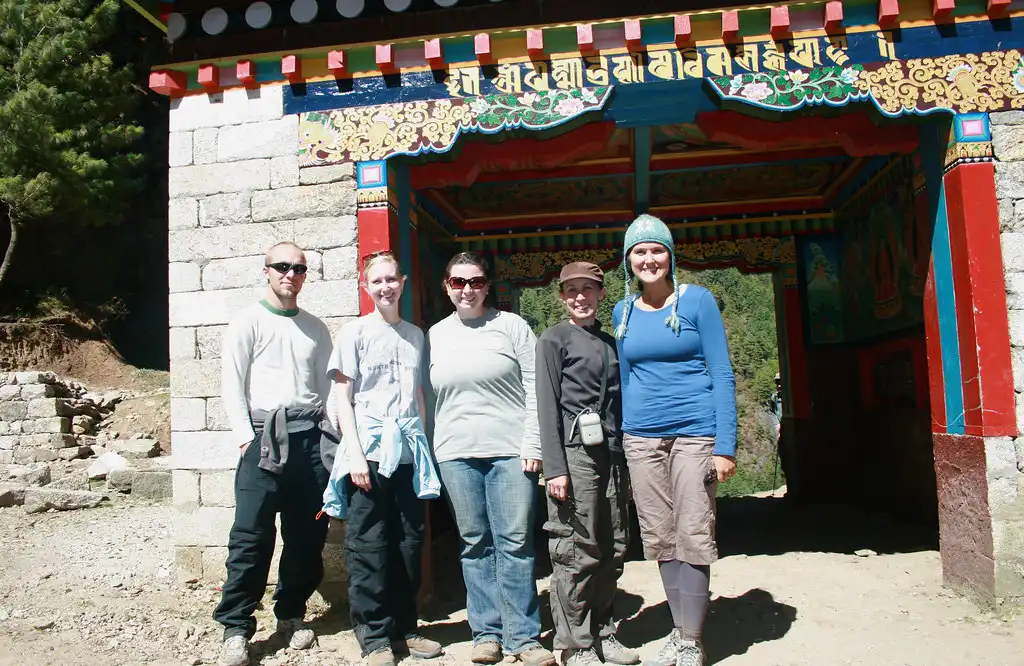
All trekkers require this permit, which supports conservation efforts and park upkeep.
- Trekkers’ Information Management System (TIMS) Card: Consider this card your trekking passport. It records your trek, which is crucial for safety and any potential rescue operations. Plus, it contributes to sustainable tourism practices in the region.
Getting Your Permits
- Hassle-Free with Peregrine Treks: The most straightforward route to obtaining permits is through a trusted trekking agency like Peregrine Treks. They’ll handle the entire application process, ensuring you have all the required paperwork.
- Going Solo: Independent trekkers can apply directly at the Nepal Tourism Board office in Kathmandu or Monjo’s Sagarmatha National Park entrance.
Important Details
- Permit Fees: Both the Sagarmatha National Park entry permit and the TIMS card have associated fees.
- Validity: Permits have specific durations. Double-check that your trek itinerary fits within the permit’s validity period.
- Keep Them Handy: Always carry your permits throughout the trek, as officials may conduct checks.
Tread Lightly
- Stick to the Trails: Stay on marked trails to minimize your impact on this sensitive environment.
- Leave No Trace: Pack out all your trash and respect the natural beauty around you.
- Camp Responsibly: Using designated campsites to protect your surroundings if you’re camping.
Trekking through Sherpa Heartland
Beyond its stunning landscapes and challenging high-altitude trails, Kongma La Pass offers a unique window into the vibrant culture of the Everest region. The Sherpa people, celebrated for their mountaineering skills and genuine warmth, have called these valleys home for generations, their lives deeply connected to the rhythms of the Himalayas.
Sherpa Villages: Living Traditions
Your trek to Kongma La Pass winds through several Sherpa villages, offering glimpses into their traditional way of life. These hardy communities have mastered living in harmony with the harsh mountain environment, their culture interwoven with Buddhist beliefs and a profound respect for nature.
Monasteries: Spiritual Havens
As you trek, look for the colorful prayer flags dancing in the breeze and the peaceful aura of Buddhist monasteries nestled amidst the mountains. These spiritual hubs hold deep significance for the Sherpa people, offering a fascinating insight into their rich religious traditions.
Respectful Trekking: Nurturing the Land and Its People
Being responsible and mindful when trekking is paramount when you trek through this sacred region.
- Cultural Sensitivity: Dress modestly, seek permission before photographing people or religious sites, and always be considerate of local customs and traditions.
- Environmental Stewardship: The Everest region boasts a delicate ecosystem. To avoid disturbing the natural environment, embrace Leave-No-Trace principles, pack out all your trash, and tread lightly.
Key Takeaways
- The Sherpa people are the heart and soul of the Everest region. Interact with them respectfully and learn about their unique culture.
- Visiting monasteries offers an exceptional opportunity to witness Sherpa’s spiritual practices. Approach these sacred spaces with reverence and respect.
- Preserving the unspoiled beauty of the Everest region requires a collective commitment. Minimize your impact and leave only footprints behind.

